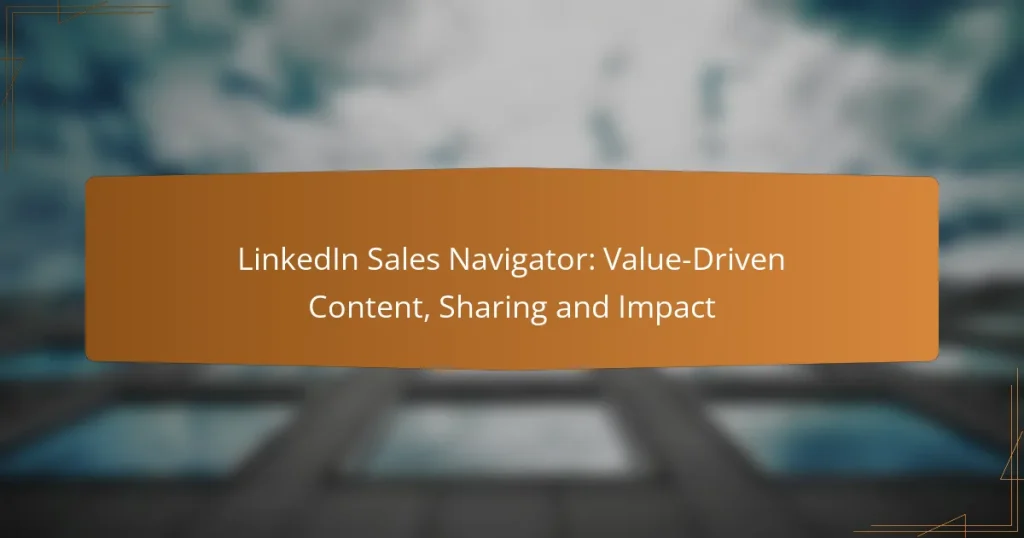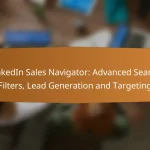LinkedIn Sales Navigator is a powerful tool for enhancing lead generation, offering advanced search capabilities and real-time insights to help sales professionals connect with the right prospects. By leveraging value-driven content, users can build credibility and foster relationships, essential for successful networking. Additionally, measuring the impact of Sales Navigator through engagement metrics and ROI analysis allows businesses to refine their sales strategies effectively.
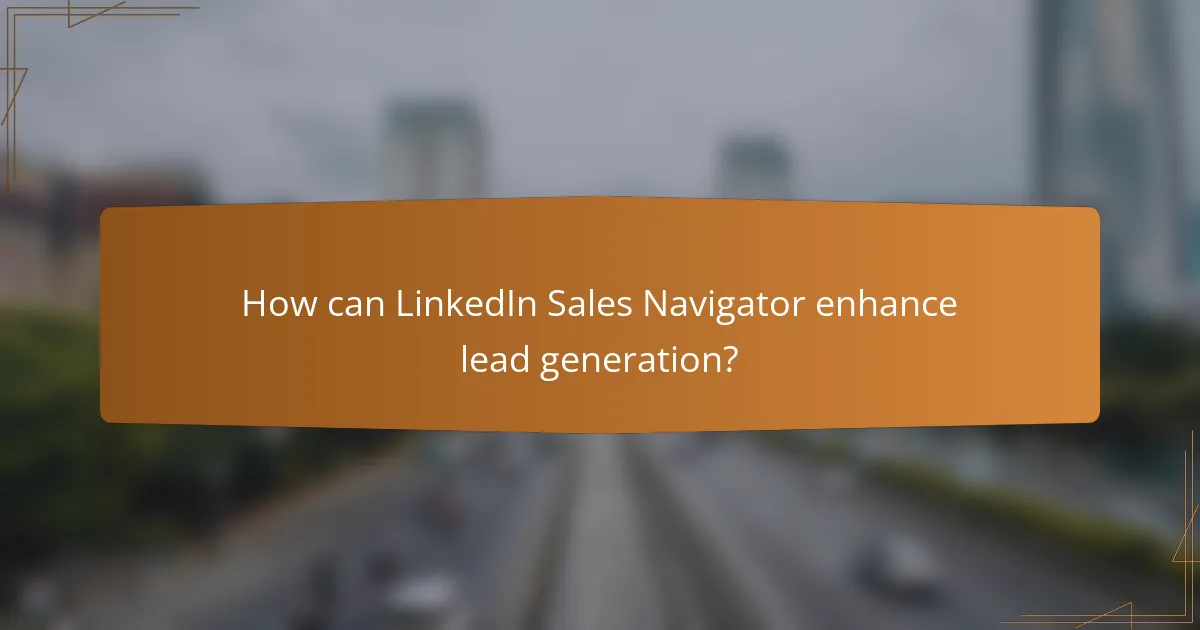
How can LinkedIn Sales Navigator enhance lead generation?
LinkedIn Sales Navigator enhances lead generation by providing tools for targeted prospecting, advanced search capabilities, and real-time insights into potential customers. These features help sales professionals identify and engage with the right leads more effectively.
Targeted prospecting
Targeted prospecting in LinkedIn Sales Navigator allows users to focus on specific industries, job titles, and company sizes. This precision helps sales teams identify leads that are more likely to convert, saving time and resources.
For example, a software company can target IT managers in mid-sized firms, increasing the chances of meaningful engagement. Utilizing saved searches and lead recommendations further refines the prospecting process.
Advanced search filters
Advanced search filters in Sales Navigator enable users to narrow down their search based on various criteria such as location, company revenue, and seniority level. This functionality allows for a more tailored approach to finding leads that fit specific business needs.
Sales professionals can use these filters to create highly targeted lists, making it easier to prioritize outreach efforts. For instance, filtering for leads in the European market with a budget over €1 million can yield high-quality prospects.
Real-time insights
Real-time insights provided by LinkedIn Sales Navigator help users stay updated on their leads’ activities and interests. This feature includes notifications about job changes, company news, and shared content, allowing for timely and relevant engagement.
By leveraging these insights, sales teams can personalize their outreach, increasing the likelihood of a positive response. For example, reaching out to a lead after they share an article relevant to your product can create a natural conversation starter.

What value-driven content can be shared on LinkedIn?
Value-driven content on LinkedIn includes materials that provide insights, demonstrate expertise, and engage your audience. This type of content helps build relationships and establish credibility, making it essential for effective networking and sales strategies.
Industry insights
Sharing industry insights involves providing data, trends, and analyses that are relevant to your field. This could include reports on market shifts, emerging technologies, or regulatory changes that impact your industry. For example, a marketing professional might share findings on consumer behavior trends that could influence advertising strategies.
When sharing insights, ensure they are well-researched and sourced from credible publications. This not only enhances your authority but also encourages engagement from peers who may share or comment on your posts.
Case studies
Case studies showcase real-world applications of your products or services, highlighting success stories and measurable outcomes. They can illustrate how your solutions have solved specific problems for clients, making them relatable and persuasive. For instance, a software company might present a case study detailing how their platform improved a client’s operational efficiency by a significant percentage.
To create compelling case studies, focus on clear narratives that outline the challenge, solution, and results. Use visuals like charts or graphs to present data effectively, and keep the language accessible to ensure it resonates with a broad audience.
Thought leadership articles
Thought leadership articles position you as an expert in your field by discussing innovative ideas, best practices, or future trends. These pieces should reflect your unique perspective and provide actionable insights that others can apply. For example, a financial advisor might write about the implications of new tax regulations on small businesses.
When crafting thought leadership content, aim for depth and originality. Engage your audience with thought-provoking questions and encourage discussions in the comments. This not only boosts visibility but also fosters a community around your expertise.

How to measure the impact of LinkedIn Sales Navigator?
Measuring the impact of LinkedIn Sales Navigator involves analyzing various metrics that reflect user engagement, conversion rates, and overall return on investment (ROI). By focusing on these key areas, businesses can determine the effectiveness of their sales strategies and optimize their use of the platform.
Engagement metrics
Engagement metrics are crucial for assessing how well your content resonates with your audience on LinkedIn Sales Navigator. Key indicators include connection requests sent, messages exchanged, and profile views. Tracking these metrics helps identify which strategies foster meaningful interactions.
To effectively measure engagement, consider using LinkedIn’s built-in analytics tools. Regularly review the number of leads saved and the frequency of interactions with those leads. This data can guide adjustments in your outreach efforts.
Conversion rates
Conversion rates indicate how effectively your engagement efforts translate into actual sales or leads. This metric can be calculated by dividing the number of successful conversions by the total number of interactions initiated through Sales Navigator. A higher conversion rate suggests that your approach is effective.
To improve conversion rates, focus on targeting the right audience and personalizing your outreach messages. A/B testing different messaging strategies can also reveal what resonates best with potential clients, leading to better results.
ROI analysis
ROI analysis helps determine the financial return generated from using LinkedIn Sales Navigator compared to its costs. To calculate ROI, subtract the total investment from the total revenue generated and divide by the total investment, then multiply by 100 to get a percentage. A positive ROI indicates that the platform is delivering value.
When conducting an ROI analysis, consider both direct and indirect benefits, such as increased brand visibility and improved lead quality. Regularly revisiting this analysis can help refine your sales strategies and justify continued investment in the tool.

What are the best practices for sharing content on LinkedIn?
To maximize engagement and impact when sharing content on LinkedIn, focus on timing, format, and audience targeting. Implementing best practices in these areas can significantly enhance visibility and interaction with your posts.
Optimal posting times
Identifying the best times to post on LinkedIn can boost your content’s reach. Generally, weekdays during business hours, particularly Tuesday through Thursday, are optimal for engagement. Aim for early mornings or lunchtime when professionals are most active.
Consider experimenting with different times to find what works best for your audience. Tools like LinkedIn Analytics can provide insights into when your followers are online, helping you refine your posting schedule.
Content formats
Utilizing a variety of content formats can keep your audience engaged. Popular formats include articles, videos, infographics, and slide decks. Each format serves different purposes; for example, videos can convey complex ideas quickly, while articles allow for in-depth exploration of topics.
Mixing formats can cater to diverse preferences within your audience. Aim for a balance between informative content and visually appealing formats to maintain interest and encourage shares.
Audience targeting strategies
Effective audience targeting is crucial for maximizing the impact of your content. Use LinkedIn’s targeting features to reach specific demographics, industries, or job titles that align with your content’s message. Tailoring your posts to resonate with these segments can lead to higher engagement rates.
Additionally, consider engaging with your audience through comments and messages to build relationships. This interaction can enhance your visibility and establish your authority in your field, making your content more likely to be shared.
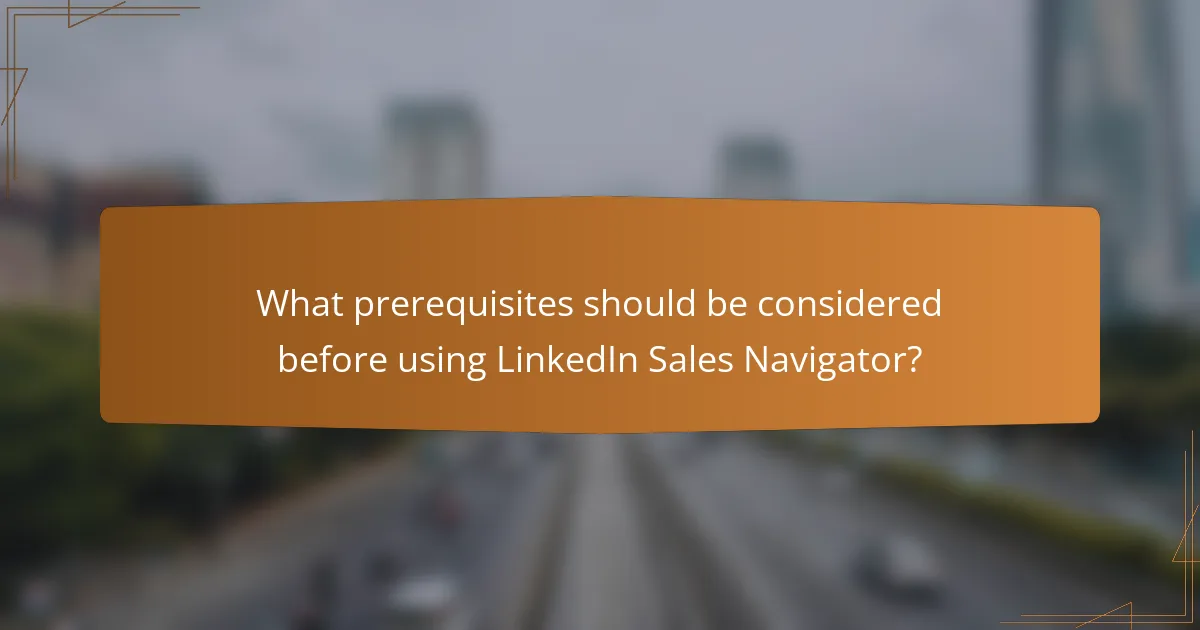
What prerequisites should be considered before using LinkedIn Sales Navigator?
Before using LinkedIn Sales Navigator, it’s essential to have a clear understanding of your target audience and defined sales goals. These prerequisites ensure that your efforts are focused and effective, maximizing the platform’s potential for lead generation and relationship building.
Understanding target audience
Identifying your target audience is crucial for leveraging LinkedIn Sales Navigator effectively. Consider factors such as industry, company size, job titles, and geographic location to create a detailed profile of your ideal customer. This focused approach helps in tailoring your outreach and messaging.
Utilize LinkedIn’s advanced search filters to segment your audience. For instance, you can filter by specific industries or regions, allowing you to connect with prospects who are more likely to engage with your offerings. Regularly updating your understanding of your audience can also help in adapting to market changes.
Defining sales goals
Clearly defined sales goals provide direction for your use of LinkedIn Sales Navigator. Establish specific, measurable objectives such as the number of leads to generate, conversion rates, or revenue targets within a given timeframe. This clarity helps in tracking progress and adjusting strategies as needed.
Consider breaking down your sales goals into smaller milestones. For example, aim to connect with a certain number of prospects each week or schedule a specific number of meetings monthly. This incremental approach not only keeps you motivated but also allows for continuous assessment of your tactics and outcomes.
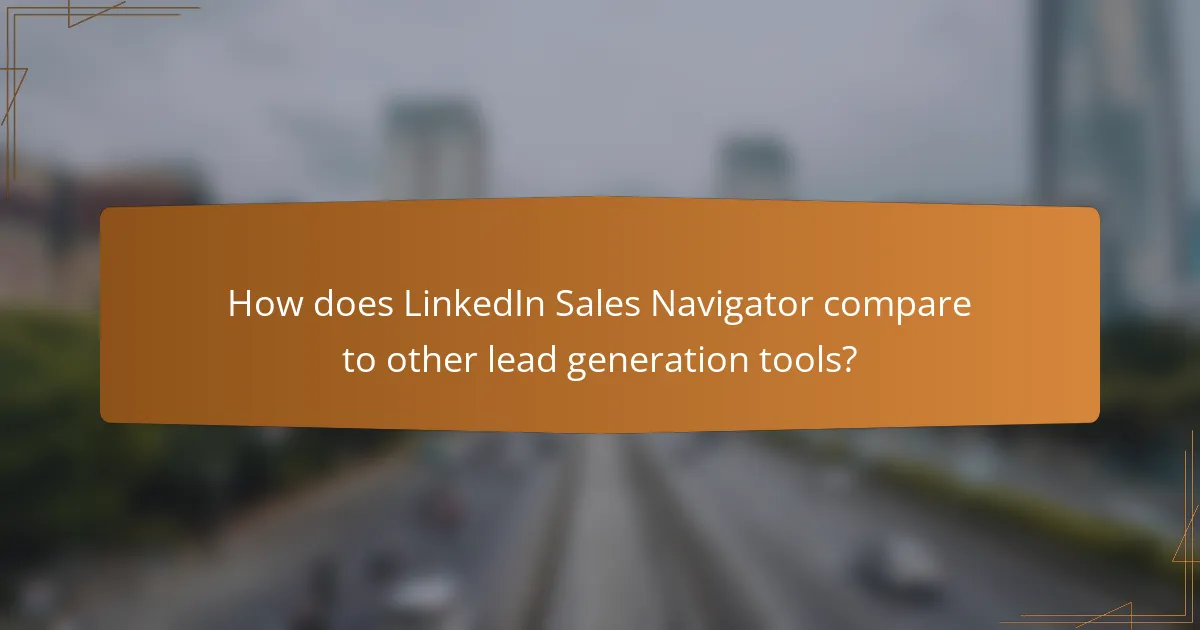
How does LinkedIn Sales Navigator compare to other lead generation tools?
LinkedIn Sales Navigator stands out among lead generation tools due to its robust features tailored for B2B sales professionals. It offers advanced search capabilities, personalized recommendations, and seamless integration with CRM systems, making it a powerful option for identifying and engaging potential clients.
Salesforce integration
LinkedIn Sales Navigator integrates smoothly with Salesforce, allowing users to sync leads and accounts directly into their Salesforce CRM. This integration helps streamline workflows, enabling sales teams to access LinkedIn insights without leaving the Salesforce platform.
Users can leverage features like InMail and connection requests directly from Salesforce, enhancing their outreach efforts. This integration is particularly beneficial for organizations that rely heavily on Salesforce for managing customer relationships and sales processes.
HubSpot compatibility
Sales Navigator also offers compatibility with HubSpot, enabling users to import leads and contacts into their HubSpot CRM. This connection allows for a more cohesive marketing and sales strategy, as teams can track engagement and interactions across both platforms.
With this integration, sales professionals can utilize LinkedIn’s insights to inform their HubSpot campaigns, ensuring that outreach is targeted and effective. It’s a valuable tool for businesses looking to enhance their inbound marketing efforts alongside their sales initiatives.
Comparison with ZoomInfo
When comparing LinkedIn Sales Navigator with ZoomInfo, both tools serve distinct purposes in lead generation. While Sales Navigator focuses on social selling and relationship-building through LinkedIn, ZoomInfo provides extensive company data and contact information, making it ideal for list building and market research.
Sales Navigator excels in personalized outreach and engagement, whereas ZoomInfo is better suited for acquiring detailed business intelligence. Depending on your sales strategy, you may choose one over the other or consider using both in tandem for a comprehensive approach to lead generation.

What emerging trends are shaping LinkedIn Sales Navigator usage?
Emerging trends in LinkedIn Sales Navigator usage include increased personalization, the integration of AI-driven insights, and a focus on value-driven content. These trends are reshaping how sales professionals engage with prospects and leverage the platform for effective lead generation.
Increased Personalization in Outreach
Sales Navigator is increasingly being used to tailor outreach efforts based on individual prospect profiles. By utilizing advanced filters and search capabilities, users can identify leads that match specific criteria, allowing for more relevant messaging. Personalization can significantly enhance engagement rates, making it essential for sales teams to invest time in understanding their prospects’ needs.
AI-Driven Insights and Recommendations
The integration of artificial intelligence into Sales Navigator is transforming how sales professionals gather insights. AI tools analyze user behavior and engagement patterns to provide actionable recommendations, such as optimal times to reach out or content that resonates with specific audiences. This can streamline the sales process and improve conversion rates.
Focus on Value-Driven Content
Value-driven content is becoming a cornerstone of successful LinkedIn strategies. Sales professionals are encouraged to share informative articles, case studies, and industry insights that address the pain points of their target audience. This approach not only builds credibility but also fosters trust, making prospects more likely to engage with sales efforts.
Enhanced Collaboration Features
Recent updates to Sales Navigator have introduced enhanced collaboration features, allowing teams to share notes, insights, and lead lists seamlessly. This fosters a more cohesive approach to sales, as team members can align their strategies and share best practices. Utilizing these features can lead to improved efficiency and better overall results.
